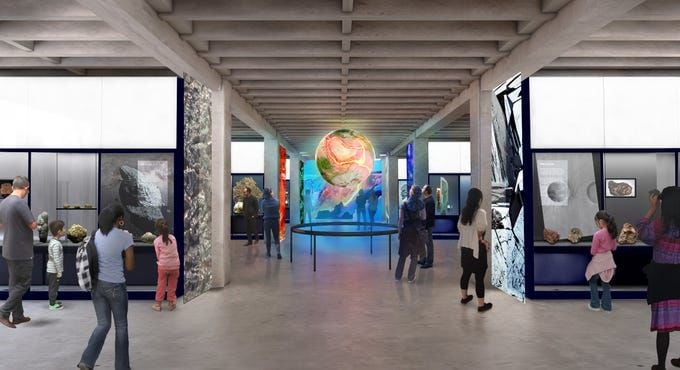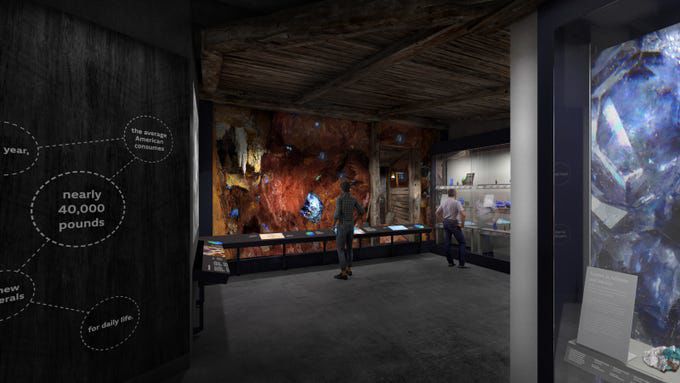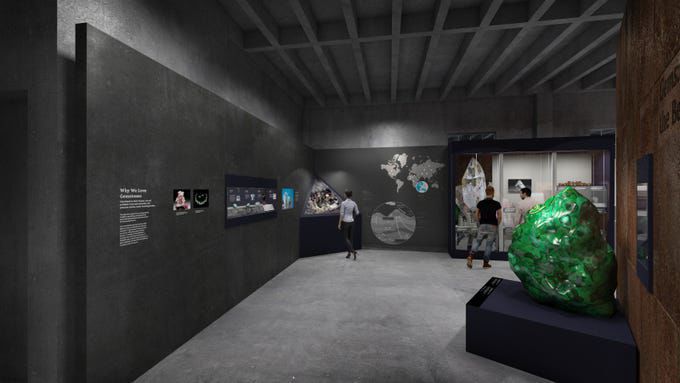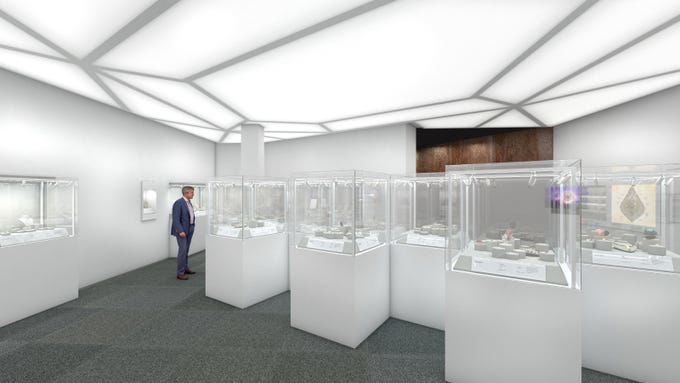From turquoise mined by indigenous people in Arizona to rocks found on asteroids within the solar system, minerals tell a story.
With its expanded space and upgraded collection, the University of Arizona Gem and Mineral Museum aims to tell this story, bringing the Tucson community together to learn about the influence that minerals have on the planet, the environment and life itself.
The museum, which will now be called the UA Alfie Norville Gem and Mineral Museum, is set to open by fall 2020 and will be located in the historic Pima County Courthouse in the heart of downtown. The courthouse, which is undergoing renovations, will also be the new home to Visit Tucson and Pima CountyŌĆÖs regional visitor center.
Currently located in the basement of the UAŌĆÖs Flandrau Science Center and Planetarium, the UA Gem and Mineral Museum will upgrade from 3,500 square feet to over 11,000 square feet in the new space.
People are also reading…
According to museum manager Eric Fritz, the bigger space provides an opportunity for the museum to expand its reach and to add more to its collection.
ŌĆ£Partnering with Pima County has been a fantastic opportunity,ŌĆØ he said. ŌĆ£WeŌĆÖre going to be right in the heart of downtown Tucson, which is undergoing an amazing revitalization, and have a chance to pull the whole university and local community together. This is also exciting because during the Gem and Mineral Show for three weeks a year, we can show off to the whole world how great this actually is.ŌĆØ
In addition to the public museum space, an additional 8,000 square feet on the lower level of the courthouse will be dedicated to a library, research lab, mineralogy lab and community classroom.
ŌĆ£WeŌĆÖll have work stations where we can do seminars and presentations and teach people about minerals and gemology,ŌĆØ Fritz said. ŌĆ£So, itŌĆÖs really an exciting space.ŌĆØ
Since the lease between the UA and Pima County was approved by the Arizona Board of Regents in April 2018, the cost of the project has grown from $9.65 million to $13.5 million. According to a lease amendment submitted to ABOR in August, the increase is due to unprecedented escalation in costs for labor and materials as well as increases in scope because of the unique nature of designing and building inside a culturally significant building.
The changes were approved by ABOR on Aug. 22.
ŌĆ£This is a very reasonable amount for the scope of both levels of the project including interactives, state-of-the-art exhibits, research lab, community space and high-density storage,ŌĆØ Fritz said.

A rendering of Bisbee-Azurite stope inside the University of Arizona Alfie Norvill Gem and Mineral Museum.
Fritz and Robert Downs, curator of the museum, said they expect to receive enough donations to cover the full cost of the project. $3.3 million in gifts have been committed to date, including a large initial donation from Allan Norville, local businessman and founder of the GJX Gem Show, on behalf of his wife, Alfie, who died in 2015.
The county has also agreed to cover the first $7.5 million spent on the project, which the UA will have to pay back with interest over a five-year period.
Plans for the museum space
The unique space will not only allow museum leaders to showcase more materials, but also provide a more interactive experience for visitors, Fritz said. While traditional mineral museums are typically filled with simple display cases with minerals inside, the new space will have immersive activities, graphics and videos.
The first exhibit, the Mineral Evolution Gallery, will focus on how the solar system and minerals have co-evolved over time.
ŌĆ£We started with 60 minerals on Earth. Any rocky planet in our solar system, any meteorite or asteroid basically has those same 60 minerals. On Earth, we now have 5,500 minerals,ŌĆØ Fritz said, ŌĆ£How did this happen? WeŌĆÖve had this sort of interaction of life and oxygen and changing minerals. ItŌĆÖs sort of been a side-by-side progression for both life and minerals and nobodyŌĆÖs ever really told that story in the same way.ŌĆØ
The next exhibit, the Arizona and Mexico gallery, will feature the unique mineralogy of the area, highlighting ArizonaŌĆÖs mining roots and turquoise trading. One section of the exhibit will be modeled after a cave within the Copper Queen Mine in Bisbee and will showcase some of the minerals that were mined there while it was still in operation.
ŌĆ£WeŌĆÖre telling the story of mining and how the copper mine in Bisbee basically set up the United States for the Industrial Revolution,ŌĆØ Fritz said. ŌĆ£Without that, we wouldnŌĆÖt have had power and telecommunications. So, it really was pivotal for our advancement in life and that was based right here in Arizona. They were mining copper before we were even a state and the copper helped make this the last contiguous state in the U.S.ŌĆØ

Rendering of the Gemstone Gallery inside of the University of Arizona Alfie Norville Gem and Mineral Museum.
In the Crystal Lab, visitors will have a chance to grow their own crystal, either a quartz, a sapphire or a diamond, and they can alter the conditions to cause a change in color.
ŌĆ£For example, if you start with a clear quartz and add a little bit of iron, youŌĆÖll end up with amethyst,ŌĆØ Fritz said. ŌĆ£So, theyŌĆÖll actually learn while doing something pretty cool.ŌĆØ
The last exhibit, the Gemstone Gallery and Treasury, will showcase minerals that have been manipulated by humans and turned into jewelry, carvings and works of art.
ŌĆ£This section of the museum shows how humans, for many thousands of years, have appreciated the beauty of minerals and itŌĆÖs a great opportunity for us because weŌĆÖve never had a gem museum as part of our collection,ŌĆØ Fritz said.
The treasury, which is a vault that will sit in the center of the gallery, will display collections of jewelry and gemstones from all over the world. The first collection to be showcased in the treasury will be the Somewhere in the Rainbow gem and jewelry collection from Phoenix.
Education and outreach
With support from the Gemological Institute of America and the American Gem Trade Association, the UAŌĆÖs Department of Geosciences is seeking to expand its emphasis on gem science and education.
A $2 million endowed chair in gem science, funded by The RealReal, will be the foundation for a course of study that will prepare students for careers in the gem and mineral industry. The university is still searching for a geoscientist to fill the seat.
The upgraded mineral museum will play a large part in the new gem sciences track, providing opportunities for students to study in the museumŌĆÖs labs and classrooms.
ŌĆ£The hope is that the classroom in the lower level will become the gem science classroom for students,ŌĆØ Fritz said.
Museum leaders are also hoping to make these areas available to local school groups and civic organizations as a way to increase the interest in mineralogy throughout the community.
ŌĆ£WeŌĆÖre coming at it from a different direction,ŌĆØ Fritz said. ŌĆ£People of all interests will get something out of it.ŌĆØ

Rendering of the Treasury inside of the University of Arizona Alfie Norville Gem and Mineral Museum.
Tucson Gem, Mineral and Fossil Showcase through the years
Photos of the Tucson Gem, Mineral, and Fossil Showcase through the years
Tucson Gem, Mineral, and Fossil Showcase

The 1967 show at the Tucson Rodeo and Fairgrounds drew a modest crowd. After its 1955 beginnings in a school auditorium, the Tucson Gem and Mineral Society moved its annual show to the Quonset hut at the Tucson Rodeo and Fairgrounds on South Sixth Ave., at Irvington Road.
Tucson Gem, Mineral, and Fossil Showcase

Exterior of Quonset on South Sixth Ave site of┬ĀTucson Gem, Mineral, and Fossil Showcase, 1956-1971.
Tucson Gem, Mineral, and Fossil Showcase

Louise Feller of Seattle looks for some gems at the Tucson Convention Center in 1991.
Tucson Gem, Mineral, and Fossil Showcase

Dealers preparing their displays near I-10 and Congress in 1991.┬Ā
Tucson Gem, Mineral, and Fossil Showcase

Mike Donovan of Texas looks at a 20-foot Pleisiosaur at the Tucson Convention Center in 1991.
Tucson Gem, Mineral, and Fossil Showcase

Tucson Convention Center full of exhibitors and buyers in 1993.
Tucson Gem, Mineral, and Fossil Showcase

Nickolai B. Kuznetsov and Alexander O. Agafonoff from Russia prepare their exhibit in a room at the Best Western Executive Inn in Tucson in 1993.┬Ā
Tucson Gem, Mineral, and Fossil Showcase

Dilip Shah of New York City conducts business while laying on his bed at the Discovery Inn in 1994.
Tucson Gem, Mineral, and Fossil Showcase

David Velk checks out some of the various Trilobites which were only one of many fossil exhibits at the gem and mineral showcase Fossil Exhibit at the Executive Inn in 1995.
Tucson Gem, Mineral, and Fossil Showcase

The first public day of the Tucson Gem & Mineral Society Show was a busy affair at the Tucson Convention Center in 1997.
Tucson Gem, Mineral, and Fossil Showcase

Gem show vendor Albert Volker, sits with his sizable collection of smokey quartz in 1998, mined by himself on his ranch in Montana. Vollker was one of the last participants doing business as most others packed up to leave.
Tucson Gem, Mineral, and Fossil Showcase

Tom Moore. Editor of the Mineralogical Record magazine, shows this drawer which has Apatite, Pyromorphite, Mimetite, and Vanadinite in 2005.
Tucson Gem, Mineral, and Fossil Showcase

Colored glass jewels glimmer with at least some of the sparkle of their rarer counterparts at the Globe-X Gem & Mineral show at the Days Inn Downtown in 2007.
Tucson Gem, Mineral, and Fossil Showcase

Yurie Ishizaka of Tokyo looks in display cases during the first day of the Tucson Gem and Mineral Show at the Tucson Convention Center on February 10, 2011.
Tucson Gem, Mineral, and Fossil Showcase

Rocks, shells, and minerals for sale at the Miner K booth at the Tucson Gem and Mineral Show at the Tucson Convention Center in 2011.
Tucson Gem, Mineral, and Fossil Showcase

Naoki Ninomiya examines a piece of Smithsonite from Mexico by putting it up to the light during the Arizona Mineral and Fossil Show as part of the 58th Annual┬ĀTucson Gem, Mineral, and Fossil Showcase at the Hotel Tucson City Center in 2012.
Tucson Gem, Mineral, and Fossil Showcase

Mike Anglin from Mission Viejo, Calif looks at agate from Argentina at the STPGM booth during the opening day of the Tucson Gem and Mineral Show at the Tucson Convention Center in 2012.
Tucson Gem, Mineral, and Fossil Showcase

A variety of Rose Quartz, Crystals, Tourmaline and Red Jasper glisten in the sunlight at Jay Gems and Minerals as they are on display at the Riverpark Inn at 350 South Freeway for the upcoming Tucson Gem, Mineral and Fossil Showcase on Jan. 23, 2017.
Tucson Gem, Mineral, and Fossil Showcase

Robert Tapia, left, and Jason Fox, warehouse manager at Superb Minerals, set up for the annual Tucson Gem, Mineral and Fossil Showcase which begins on January 26 and ends February 11. The store located at 1243 N. Main Ave sells zeolites from India. January 02, 2018.
Tucson Gem, Mineral, and Fossil Showcase

Matthew Schmalz browses through polished agate geodes as he's framed by a slice of amethyst quartz in the Western Woods tent at the Pueblo Gem and Mineral Show at the Riverpark Inn, 777 W. Cushing Street, on Jan. 24, 2018, in Tucson.
Tucson Gem, Mineral, and Fossil Showcase

Scott Sprencz, right, and Ed Kloehn, haul in an onyx luminary for the "Art of Decor Onyx" booth at the Tucson 22nd Street Mineral and Fossil Show, located on the northeast corner of 22nd Street and Interstate 10, on Jan. 24, 2018, in Tucson.
Tucson Gem, Mineral, and Fossil Showcase

Mike Pendle, from the United Kingdom, scrutinizes a quart point at the Tucson 22nd Street Mineral and Fossil Show, located on the northeast corner of 22nd Street and Interstate 10, on Jan. 24, 2018, in Tucson, Ariz.
Tucson Gem, Mineral, and Fossil Showcase

Tsiriry Anjarihva sorts hand-carved decorative heart pieces for display while workers at the Madagascar Minerals Gem Show, 201 W. Lester St., prepare for the 2019 Tucson Gem, Mineral and Fossil Showcase, Jan. 23, 2019, in Tucson, Ariz. Eighty percent of the minerals on display at Madagascar Minerals are direct from the company's mines and factories in Madagascar.
Tucson Gem, Mineral, and Fossil Showcase

Zoey Petitt selects a bag of green opals to buy at the Madagascar Minerals Gem Show, 201 W. Lester St., Jan. 23, 2019, in Tucson, Ariz. Eighty percent of the minerals on display at Madagascar Minerals are direct from the company's mines and factories in Madagascar.
Tucson Gem, Mineral, and Fossil Showcase

Celia Tessier, left, and Emma Martinez, 16, huddle together and stay warm as they examine a crystal they are weighing for a customer in the Cristais Maia booth at the Tucson Gem, Mineral and Fossil Showcase iin 2016. Martinez helps out at the Brazilian business annually during the show.
Tucson Gem, Mineral, and Fossil Showcase

Wade Leschyn, center, is dwarfed by the fossils of "Bob" the triceratops, left, and a wooly mammoth fossil from Russia at the GeoDecor booth at the Mineral and Fossil Co-op show, 1635 N. Oracle Road, Feb. 7, 2019, in Tucson, Ariz. The co-op's show, part of the the larger Tucson Gem, Mineral and Fossil Showcase.
Tucson Gem, Mineral, and Fossil Showcase

Kate Mull, right, and her daughter Grace, both visiting from West Virginia, sport their t-shirts Kate bought especially for the gem show as they browse the displays at Rosman Gems at the Mineral and Fossil Co-op show, 1635 N. Oracle Road, Feb. 7, 2019, in Tucson, Ariz.


















